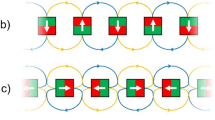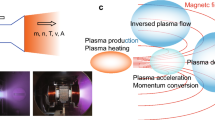Abstract
Gyrotron oscillators are powerful millimeter, sub-millimeter and even potential THz wave sources, capable of reaching megawatt power levels. They are widely studied today to use for electron cyclotron resonance heating, current drive, stability control and active diagnostics of magnetically confined fusion plasmas. To suppress the parasitic modes and improve the efficiency of the over-mode resonator is a important object for the design of high power gyrotrons. On the basis of electron cyclotron resonance maser theory and generalized transmission line theory, we compiled programs to analyze the resonant cavity in a 110 GHz gyrotron. The results shows that the coupling coefficient to parasitic modes of gradually tapered cavity is obviously less than line-joint cavity. By calculating and studying different gradual-varying and line-joint resonant cavities, we designed a gradually tapered resonator for a 110 GHz gyrotron, which is good at suppressing the parasitic modes, improving the purity of the operating mode and the efficiency of the beam–wave interaction.
















Similar content being viewed by others
References
M.E. Read, S.N. Gregory, G.B. Dumbrajs, IEEE Trans. Plasma Sci. 24, 586 (1996)
M. Thumm, Recent advances in the worldwide fusion gyrotron development. IEEE Trans. Plasma Sci. 42(3), 590–599 (2014)
M. Thumm, Progress on gyrotrons for ITER and future thermonuclear fusion reactors. IEEE Trans. Plasma Sci. 39(4), 971–979 (2011)
X.J. Niu, X.H. Yu, S.M. Li, X. Gao, W.P. Cao, Y.N. Jiang, H.F. Li, High-power TE01–TE11 mode converter for gyroklystron. J. Fusion Energ. 32(4), 426–430 (2013)
T. Kobayashi, A. Isayama, M. Sawahata, S. Suzuki, M. Terakado, S. Hiranai, K. Wada, Y. Sato, J. Hinata, K. Yokokura, K. Hoshino, K. Kajiwara, K. Sakamoto, S. Moriyama. Dual frequency gyrotron development for JT-60SA, in 37th International Conference on Infrared, Millimeter, and Terahertz Waves, September 2012, pp. 1–2
D.S. Tax, W.C. Guss, M.A. Shapiro, R.J. Temkin, Experimental research on a 1.5 MW, 110 GHz gyrotron, in Abstracts IEEE International Conference on Plasma Science, July 2012, pp. 4B-3–4B-3
T. Manfred, in Conference of 13th International Vacuum Electronics Rome, 28–30 April 2009, p. 37
T. Anthony, K.R. Chu, A. Bromborsky, IEEE Trans. Electron Device 34, 2621 (1987)
K. Felch, M. Blank, P. Borchard, P. Cahalan, S. Cauffman, Recent high-power gyrotron activities at 95, 110 and 170 GHz, in IVEC 2012, April 2012, pp. 109–110
M. Thumm, T. Rzesnicki, B. Piosczyk, I. Pagonakis, F. Li, J. Jin, J. Jelonnek, S. Illy, G. Gantenbein, K. Avramides, S. Alberti, J.-P. Hogge, S. Kern, I. Tigelis, M.Q. Tran, Experimental results and recent developments on the EU 2 MW 170 GHz coaxial cavity gyrotron for ITER, in EPJ Web of Conferences, Vol 32, 2012, p. 04009
H.J. Huang, Microwave Principle (Science Press, Beijing, 1965)
Y.-H. Liu, X.-J. Niu, S. Yu, H.-F. Li, J. Yao, J. Zhou, C.-J. Lei, H. Jiang, Y. Yang, Design and experimental demonstration of a 94-GHz gyrotron with complex cavity operating at the second harmonic. J. Fusion Energ. 32, 182–188 (2013)
L. Hong-fu, M. Lin, Analysis and numerical results of complex-cavity gyrotron. Acta Electron. Sin. 19(2), 8–12 (1991)
E. Borie, O. Dumbrajs, Calculation of eigenmodes of tapered gyrotron resonators. Int. J. Electron. 60(2), 143–154 (1986)
J.S. Hummelt, A.M. Cook, M.A. Shapiro, R.J. Temkin, 1.5 MW, 110 GHz gyrotron breakdown in air, in IVEC 2012, April 2012, pp. 335–336
J.S. Hummelt, A.M. Cook, M.A. Shapiro, R.J. Temkin, Experimental investigation of air breakdown utilizing a 1.5 MW, 110 GHz gyrotron, in Abstracts IEEE International Conference on Plasma Science, June 2011, p. 1
K. Kreischer, S. Korbly, M. Shapiro R. Temkin, The development of a 1.5 MW, 110 GHz gyrotron for plasma heating, in IEEE Conference Publications. Abstracts, May 2000, p. 2
K.A. Avramides, O. Dumbrajs, J.L. Vomvoridis, S. Kern, Gyrotron interaction simulations with tapered magnetostatic field, in Infrared Millimeter and Terahertz Waves, September 2010, pp. 1–2
Acknowledgments
This work has been supported in part by two grants of the National Natural Science Fund Committee of China. (Grant No. 11205026).
Author information
Authors and Affiliations
Corresponding author
Rights and permissions
About this article
Cite this article
Liu, Yh., Liu, Q., Niu, Xj. et al. Analysis and Design of the Resonator in a 110 GHz Gyrotron Oscillator. J Fusion Energ 34, 456–462 (2015). https://doi.org/10.1007/s10894-014-9817-z
Published:
Issue Date:
DOI: https://doi.org/10.1007/s10894-014-9817-z




